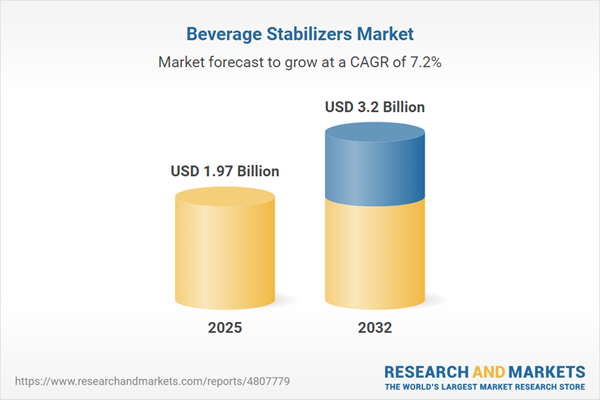Speak directly to the analyst to clarify any post sales queries you may have.
The beverage stabilizers market is evolving rapidly as industry leaders respond to regulatory developments, advances in processing technology, and the increasing importance of supply chain resilience. Senior executives must anticipate these drivers to prioritize innovation, compliance, and competitiveness in a changing environment.
Beverage Stabilizers Market Snapshot
Consistent annual growth characterizes the beverage stabilizers market, with innovation in ingredient science and closer collaboration between manufacturers and suppliers propelling this momentum. Growing investments in advanced processing and formulation have enabled improved product clarity and enhanced durability, allowing beverage businesses to adapt as consumer preferences shift. This market encourages continuous agility, supporting brand differentiation while rewarding operational efficiency in both established and developing regions. As organizations focus on optimizing supply chains and broadening product ranges, their ability to absorb market volatility is reinforced by an adaptable presence in both mature and emerging locations.
Scope & Segmentation: Industry Overview
A thorough understanding of the beverage stabilizers market requires careful analysis of its primary segmentation and operational factors. These elements help decision-makers uncover new opportunities and enhance procurement strategies:
- Form: Gel, liquid, and powder stabilizers support varied production needs and facilitate rapid reformulation as processing methods evolve.
- Type: Acidulants, antioxidants, emulsifiers, gums and hydrocolloids, preservatives, proteins, stabilizing agents, and thickeners are integral for maintaining taste, texture, and shelf life in beverage applications.
- End-User: Solutions cater to alcoholic and non-alcoholic beverage producers, brands concentrating on dairy alternatives, wellness-focused enterprises, and manufacturers seeking regulatory compliance and formulation uniformity.
- Distribution Channel: Online and offline procurement options equip buyers with adaptable acquisition models and broader access to diverse suppliers.
- Regional Coverage: Operations span the Americas, Europe, Middle East and Africa, and Asia-Pacific, with strategic growth in China, India, and Southeast Asia reinforcing activities in more established regions.
- Key Players: Companies such as Cargill, Ingredion, Tate & Lyle, Kerry Group, CP Kelco, Palsgaard, Ashland Global Holdings, DuPont de Nemours, Nexira, and Glanbia Nutritionals shape the market through impactful strategies and industry benchmarks.
Key Takeaways for Senior Stakeholders
- Plant-based and natural hydrocolloid stabilizers help businesses adapt supply chains and meet clean-label product goals while supporting innovation in beverage formulations.
- Expansion of digital manufacturing technologies, such as real-time viscosity controls and inline rheology monitoring, is improving product quality and ensuring consistent output across multiple production batches.
- Organizations benefit from seamless documentation and robust supply chain traceability, both of which support regulatory compliance and reduce operational risks.
- Diversified supplier networks and advanced contingency planning strengthen procurement strategies, helping organizations maintain resilience during periods of supply chain disruption.
- Growing investment in nutrition and dairy alternative beverages is creating opportunities for quicker product development and closer alignment with emerging consumer health preferences.
- Collaboration in research and development with key suppliers is enabling faster product launches and promoting distinct brand positioning.
Tariff Impact and Supply Chain Optimization
Recent U.S. tariff changes have increased costs for key stabilizer inputs, such as citrus-based pectins and specialty gums. To offset these impacts, companies are renegotiating supplier agreements and strengthening collaboration with logistics and customs professionals. The introduction of digital procurement solutions enables proactive cost management and effective risk mitigation, maintaining stable global supply chains and organizational responsiveness even as external pressures fluctuate.
Secondary Keywords Insight: Emulsifiers and Hydrocolloids
Emulsifiers and hydrocolloids remain fundamental to beverage formulation, ensuring label precision and supporting companies in meeting compliance requirements. Their strategic use helps achieve reliable product quality and supports success in both established and emerging beverage sectors.
Methodology & Data Sources
This report is based on comprehensive secondary research, input from subject-matter experts, and targeted market surveys. Each insight presented is validated, empowering senior decision-makers with trustworthy intelligence for strategic planning.
Why This Report Matters for Decision-Makers
- Provides actionable frameworks for supplier engagement, compliance management, and integration of emerging technologies within the beverage stabilizers market.
- Equips executive teams with adaptable risk management tools for evolving regulatory demands and digital transformation priorities.
- Delivers timely, in-depth market analysis to help organizations sustain a competitive edge through periods of industry transition.
Conclusion
With comprehensive industry analysis and expert insights, this report supports executive leaders in achieving strategic growth, fostering ongoing innovation, and effectively managing market risks as the beverage stabilizers sector continues to change.
Additional Product Information:
- Purchase of this report includes 1 year online access with quarterly updates.
- This report can be updated on request. Please contact our Customer Experience team using the Ask a Question widget on our website.
Table of Contents
3. Executive Summary
4. Market Overview
7. Cumulative Impact of Artificial Intelligence 2025
Companies Mentioned
The companies profiled in this Beverage Stabilizers market report include:- Cargill, Incorporated
- Ingredion Incorporated
- Tate & Lyle PLC
- Kerry Group PLC
- CP Kelco
- Palsgaard A/S
- Ashland Global Holdings Inc.
- DuPont de Nemours, Inc.
- Nexira
- Glanbia Nutritionals
Table Information
| Report Attribute | Details |
|---|---|
| No. of Pages | 181 |
| Published | November 2025 |
| Forecast Period | 2025 - 2032 |
| Estimated Market Value ( USD | $ 1.97 Billion |
| Forecasted Market Value ( USD | $ 3.2 Billion |
| Compound Annual Growth Rate | 7.1% |
| Regions Covered | Global |
| No. of Companies Mentioned | 11 |









